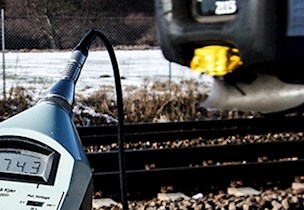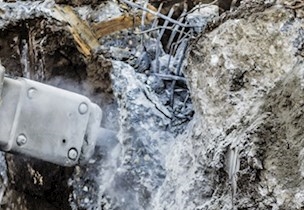Listen to the road of the future
When the Danish Road Directorate plans new roads and road reconstructions around the country, it entails a need to inform stakeholders such as citizens, politicians, expropriation commissions, and technicians how noise from the new road will sound.
Naturally, neighbours living next to these road projects worry how the traffic noise might affect them in the future. Thus, at public meetings citizens show great interest in influencing these projects with the aim of keeping the noise at a minimum.
The Danish Road Directorate wants to provide as proper information as possible about road noise when informing neighbours about the impact of a road project. Emphasis is also placed on providing information about the effect of various noise-reducing measures such as noise barriers or noise-reducing surfaces or speed limit adjustments and changes in volume of traffic etc. But explaining noise by the use of words and pictures is a difficult task.
Maps of road noise are mainly for the eye
Usually, noise emission is described in an environmental impact assessment (EIA) by means of noise maps and tables showing numbers of affected households. But for laymen and many technicians too, it can be difficult to relate to noise maps and descriptions such as “the use of noise-reducing asphalt will reduce the noise by 2 dB”. It seems unnatural to use visual applications to describe something audible.Therefore, the Road Directorate in cooperation with FORCE Technology has prepared an auralisation tool that can create audio presentations of the road traffic noise.
“The idea behind the auralisation tool arose because we needed a tool that could improve our communication to the stakeholders about noise,” says Engineer and Project Manager at the Danish Road Directorate, Jakob Fryd, who has many years of experience communicating with citizens about road traffic noise.
The sound of road noise
Auralisation enables you to hear how future outdoor noise sources, e.g. roads and wind turbines, will sound in different situations and landscapes – just like a visualisation. Who wants to build a road without seeing the visual impact on the landscape?
Like the word ‘visualisation’ means ‘to create an image of something’, it is possible to define ‘auralisation’ as ‘creating a soundscape of something’. That is the road will sound like this. Thus, auralisation is a suitable tool for communicating sound scenarios (under the right conditions).
The auralisation tool can also be used to clarify how noise exposure from road traffic may differ under certain conditions. E.g. how does upwind or downwind influence the sound, and what is the influence of increased traffic vehicles or increased number of heavy vehicles? This can be studied and heard using auralisation.
Learn more about auralisations in What does a motorway sound like?
Sound library with years of sound recordings of road noise
The auralisation tool is based on an extensive sound library containing numerous sound recordings of car passings from different types of roads. The recordings are collected over a number of years and recorded in an excellent sound quality without background noise or other disturbing noise. For the auralisation the recordings are adjusted to match actual distance, terrain and wind conditions, so the recordings correspond exactly to the current example. The audio recordings are then mixed into audio files of 1-2 minutes’ duration. The sound files contain a carefully balanced number of car pass-bys corresponding to the traffic data for the relevant period in question. At the current stage, the playback of audio files can be instantly interchanged in a way that makes it possible to directly compare situations like e.g. a standard road surface to a sound reducing surface.
Listen to road noise sound examples (auralisations).
Results with the auralisation tool
The auralisation tool already has had a successful introduction at public meetings in connection with the extension of route 18 between Herning and Holstebro. At the public meetings there was a booth with 8 headphones and a display monitor. Here people could listen to different sound situations and evaluate the difference in the noise level between an existing road with a speed limit of 80 km/h and a motorway of 130 km/h. It was also possible to hear auralisations with different noise reducing measures such as noise barriers and noise-reducing asphalt.Jakob Fryd participated in the public meetings and has shared the tool with several colleagues. He finds that people are very positive towards the new auralisation tool:
“In my experience people are surprised when they listen to the sound samples, because often people have different expectations as to how much or how little for example a noise-reducing surface will alter the noise.”
In the future Jakob Fryd expects that the auralisation tool will be used in many contexts:
“To make the auralisation tool has required numerous introductory exercises. Now we have a good method that we can use more systematic and inexpensively incorporate in different projects. For example, if there is a debate about whether to set up a noise barrier along a motorway, the residents can now sense how great or small the effect will be. Also, internally we can use the auralisation tool for educational purposes to give our colleagues in the Road Directorate and other decision-makers a greater understanding of road noise.”
The auralisation tool will be updated continuously and adapted with new audio recordings.
Listen and learn the effect of road noise
You can listen to the auraliations here in Danish.On the website there is a guide for adjusting the sound level. The actual sound recordings are downloaded and played using FORCE Technolgy's special developed platform, SenseLabOnline, which is particularly suitable for playing and comparing audio recordings. Currently, the instructions are only in Danish.
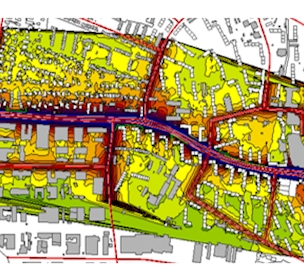
Traffic noise is dangerous to our health
/Article
Every year, at least 200-500 Danes die prematurely due to traffic noise – what can we do about it?
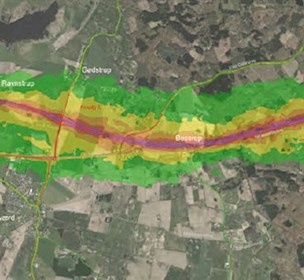
What does a motorway sound like?
/Article
Find out how auralisation is used to explain the scope and impact of road noise.
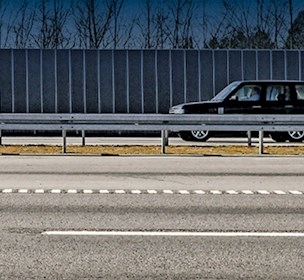
Auralisations: The sound of road noise
/Article
Listen to auralisations of traffic noise i different situations.


